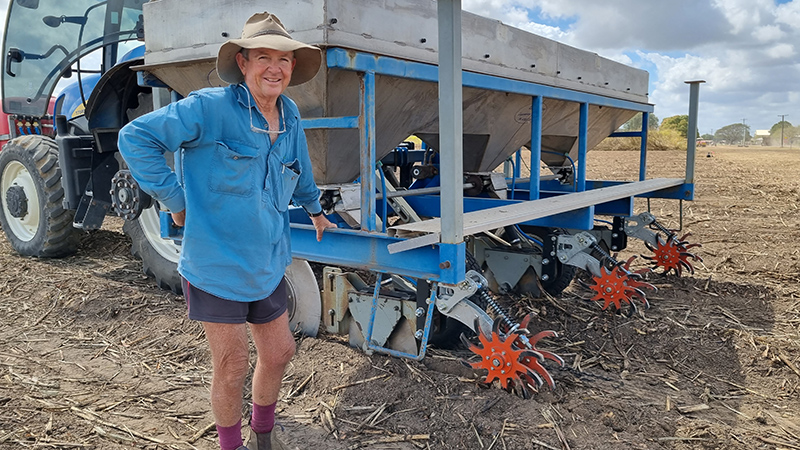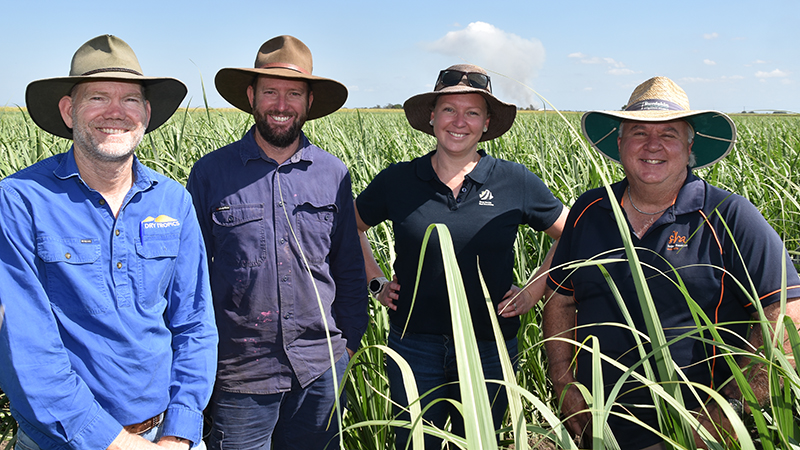Precision To Decision
(Part of the Lower Burdekin Water Quality Program delivered by Farmacist Pty Ltd.)
AT A GLANCE
- 103 farms in land management practice changes on 13,066 ha
- 25,106 kg/y reduction in DIN
- 10,413 ha of Electromagnetic Soil mapping to identify soil zones.
- 60 individualised Precision Agriculture folders providing growers with ready access to their data.
- 40 prescription amelioration maps used by contractors for precision amelioration application.
- 200 soil tests undertaken to identify unknown soil constraints.
- 200 water tests undertaken to identify usable nitrates in irrigation groundwater.
- 280 new nutrient management plans and budgets prepared.
- 58 Fertiliser Box calibrations to ensure accurate fertiliser application.
Pictured, from left, are: Grower Andrew Cross, NQ Dry Tropics Sugarcane Team Leader Luke Clark, and Farmacist Director and Agronomist Jayson Dowie.
ANDREW CROSS
Gaining a better understanding of his soil types allowed Upper Haughton grower Andrew Cross to fine tune nutrient application — saving money and helping to prevent runoff to the Great Barrier Reef.
With the cost of inputs rising steeply, Andrew Cross understands the importance of being more precise about how and where he applies soil ameliorants. He said he joined the Precision to Decision (P2D) project to access better quality soil data, which was helping him make more informed farm management decisions.
Mapping and soil testing support
“I have always been big on data, you can never have enough,” Andrew said.
“The trouble is gathering it. Margins are tight and although we’re a big operation with plenty of staff, everyone’s busy.”
Thanks to support from agronomy company Farmacist, Andrew accessed extensive electromagnetic (EM) soil mapping, which, combined with georeferenced soil testing, has given him the necessary data to farm more efficiently.
“Blanket ameliorations are too expensive, with the price of mill mud and gypsum just about doubling,” Andrew said.
“Joining the project has allowed me to fast-track my understanding of the soil variations across the farm.
“It would’ve taken 10 years to map everything out, and we haven’t got everything done, but we’re close now, probably around 85-90 per cent.
“It’s been fantastic to get it done that quickly.”
Andrew said the mapping data had enabled him to divide his paddocks into zones according to soil type, supported by Farmacist’s Jayson Dowie.
“I would chat with Jayson about the number of zones, and once we had narrowed it down, we would get the soil tests done, because a map is useless until you pair it up with a soil test,” he said.
“Without assistance it is hard to get around to soil testing because things get so busy and come Christmas time, the cane is high, and you’ve missed your chance.”
A win-win for productivity and the environment
Jayson said precision farming relied on a variety of precision data sets.
“Understanding our soils is important because in one block you can have sand, loam, and clay soils, and then some really challenging stuff on top of that,” he said.
“By understanding the different chemistry of these soils, we can come up with an appropriate management plan.
“If we take a soil sample in a particular spot and Andrew puts gypsum or some other ameliorant, mud, ash or whatever, we can come back to that exact spot in five years and have a look at the changes.
“We can identify that part of a paddock may need 8 or 10 tonnes per hectare, whereas a vast portion of it might only need 2 tonnes per hectare.
“So, we strategically figure out where we can apply the product to get the biggest bang for buck.
“Without this technology, you’d probably put 5 tonnes per hectare across the block and end up not putting enough on the areas that need it, and too much on the areas that don’t.”
Jayson said nitrogen-use efficiency was an important part of the P2D project.
“Not only does that come from appropriate fertiliser selection and nitrogen application, it’s also about growing bigger crops that have the ability to take up more nitrogen and prevent it potentially ending up in catchments running out to the Great Barrier Reef.
Grower Andrew Cross.
Farmacist’s electromagnetic mapping vehicle in action.
“It’s a win-win for the environment, and for Andrew’s profitability.”
Andrew said the soil data had given him the confidence to cut his losses on a poor-performing paddock.
“As soon as we mapped it and took a look. That was it — we ploughed it out, otherwise, it would be growing another very poor crop of cane right now,” he said.
“I’d rather spend money on country that can better convert it.”
Data will provide long-term benefits
Jayson said the EM mapping would serve Andrew well for years to come.
“It’s given Andrew a bit of legacy after the project and that’s what we try to do,” he said.
“He’ll always have these spatial data sets that he can keep building on.
“We don’t know what new developments in precision ag is going to come in six, eight, 10-years time, but if we can get our baseline data sets down pat now, it can only help into the future.”
FURTHER READING
LOWER BURDEKIN WATER QUALITY PROGRAM
Stool Zippas

NQ Dry Tropics’ Major Grants project encouraged growers to invest in equipment, technology or agronomic services to reduce the amount of nitrogen fertiliser applied to their crop. Some opted for Stool Zippas .
READ MORE>>
Innovations Day

Lower Burdekin cane growers heard about the “latest and greatest” innovations available to improve efficiency, profitability and sustainability at a Field Day on Aaron Linton’s Home Hill farm recently.
READ MORE>>
Program home

Between 2020 and 2024, more than 100 cane growers have improved irrigation, nutrient and pesticide management, resulting in widespread practice change and significant water quality improvements.
READ MORE>>
Irrigation project

Wilmar Sugar and Renewables and Ross and Lisa Parker’s farms are the subjects of two case studies under this project.
READ MORE>>
Major Grants

Innovation has long been a driver of improved profits, improved application of water, fertiliser and pesticide on sugar cane crops. Innovations that lead to increased profitability and resilience for the grower and reduced runoff from farms for the Great Barrier Reef are the things that excite us.
READ MORE>>
Bluewater

Optimising the amount of pesticide and the delivery of pesticide can save growers thousands of dollars, but it also helps to reduce run off and loss of chemical that could end up in waterways flowing out to the Great Barrier Reef.
READ MORE>>



